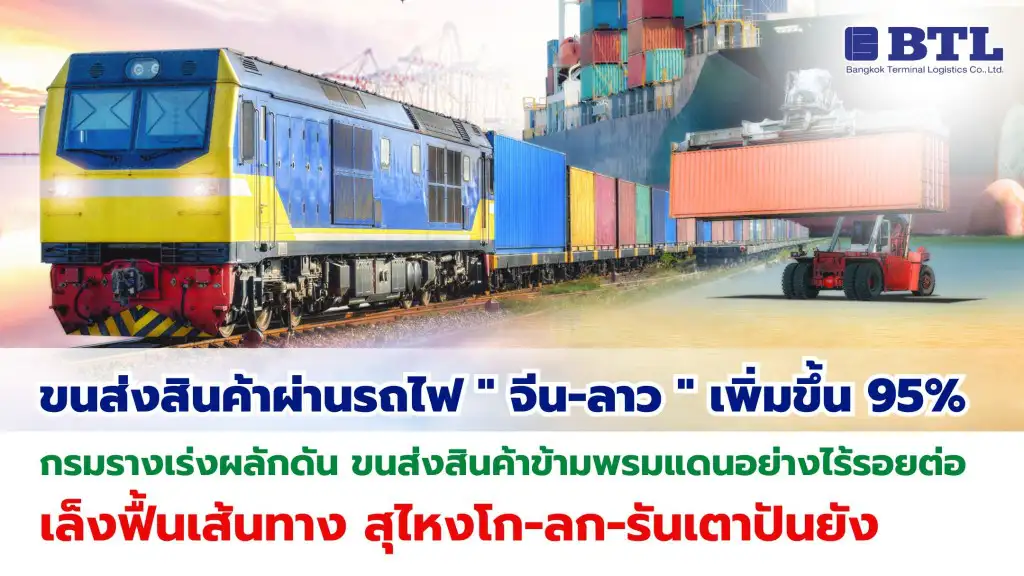



The China-Laos Railway project is a major project connecting Kunming, China, and Vientiane, Laos, under the Belt and Road Initiative.
The Department of Railways is accelerating the seamless transportation of goods across borders, aiming to revive the Thailand-Malaysia railway route. The China-Laos Railway project is an important project connecting Kunming City, China, with Vientiane Capital, Lao PDR. It began operations on December 3, 2021. It is the flagship project of China’s “One Belt, One Road” (BRI) initiative and the Lao PDR’s strategy to transform a landlocked country into a land transportation hub.
The China-Laos Railway facilitates the transportation of goods, such as iron ore, cassava, and rubber, which were imported into China for the first time and are now being sent to countries in Europe and Central Asia via China-Europe freight trains. In addition, China also exports mechanical and electrical products and various high-tech products to ASEAN countries.
The China-Laos Railway is a large-scale transportation network covering more than 30 cities in the Bohai Sea area in northeast China, the Yangtze River Delta in east China and the Pearl River Delta in south China.
It also connects the transportation networks of 12 countries along the Belt and Road Initiative, such as Laos and Thailand, to promote trade and investment between China and ASEAN countries. The China-Laos Railway is 1,035 kilometers long and trains can run at a speed of 160 kilometers per hour.
There are both passenger and freight trains. This project is part of the Kunming-Singapore Railway Project, which connects Kunming to Singapore via Laos, Thailand and Malaysia.
The Department of Railways recently joined the “Thai-Malaysia” Railway (RJWC) meeting to find ways to increase convenience in seamless cross-border freight transport, pushing for the reopening of the Sungai Kolok-Rantau Panyang railway route after being closed for more than 20 years, and the possibility of connecting with a high-speed train.
On January 17, 2024, Mr. Pichet Kunathammarak, Director-General of the Department of Rail Transport (DRT), and Mr. MOHD SHAHRIMAN BIN SHAFEIN, Director-General of the Department of Railways, Federation of Malaysia, co-chaired the 2nd Thailand and Malaysia Railway Joint Working Committee (RJWC) meeting.
To promote the integration of railway connections between Thailand and Malaysia, along with Mr. Atiphu Jitranukroh, Deputy Director-General of the Department of Rail Transport, representatives from the Office of Transport and Traffic Policy and Planning (OTP), the Customs Department, the Immigration Bureau, the National Economic and Social Development Board (NESDB), the Railway Technology Research and Development Institute (Public Organization), and the State Railway of Thailand (SRT) joined.
Mr. Pichet Kunathammarak, Director-General of the Department of Rail Transport, said that in the meeting, both parties expressed their commitment to continue the ongoing cooperation on railways between Thailand and Malaysia.
Both sides agreed to cooperate to develop rail infrastructure and facilitate the transportation of goods and passengers between the two countries to promote trade, investment and tourism between the two countries.
Following the meeting between the two leaders, Mr. Settha Thavisin, Prime Minister of Thailand and Dato’ Seri Anwar bin Ibrahim, Prime Minister of Malaysia in October and November 2023, which confirmed the importance of joint border development and emphasized the shared commitment to improve the quality of life of the people and promote increased trade and investment between Thailand and Malaysia.
For the issues that both parties discussed on the cooperation in railways between Thailand and Malaysia, the following issues were discussed:
1. Seamless cross-border rail travel. Both sides discussed ways to facilitate rail transport of goods across the Thai-Malaysian border in terms of standards, regulations and seamless cross-border transport, including the amendment of the agreement between the Government of the United Malaya and the Government of Siam to facilitate rail travel between the Kingdom of Siam and Kelantan, Saiburi, Perlis and the United Malaya in 1922.
The focus is on reducing transportation time and costs, as well as coordinating customs and immigration procedures, safety and security in cross-border train travel, especially in Narathiwat Province, Tak Bai District, and the possibility of connecting the Sungai Kolok-Pasemas railway route with Malaysia’s East Coast Rail Link (ECRL).
The Thai side is ready to reopen the Su-ngai Kolok-Rantau Panyang route, which used to be a railway route used for mass transportation and goods in the past and has been out of service for more than 20 years.
Due to security issues in Thailand’s southern border provinces and the problem of illegal goods smuggling, the SRT has renovated the railway bridge on the Thai-Malaysian border, ending at the southern railway line at Sungai Kolok.
And the Thai side presented information on the progress of the development of the double-track southern railway line in Thailand to the Malaysian side.
In addition, there were discussions on academic cooperation in the field of rail systems, such as the exchange of training for personnel in the field of rail systems, as well as the review and amendment of the 1954 Thailand-Malaysia Railway Agreement.
(1954) To be up-to-date and in line with the current situation.
2. Rail infrastructure connectivity: Both sides discussed the possibility of connecting the high-speed rail between Thailand and Malaysia. The next meeting is scheduled for August 2024.
Malaysia will host the 3rd Working Group Meeting to follow up on issues that need to be jointly pushed forward in the next phase.
Source of information: Prachachat Business
https://mgronline.com/business/detail/9670000005097
https://www.nationtv.tv/foreign/378938549
————————–
Contact us for BTL service inquiries
02-681-2005 to 9